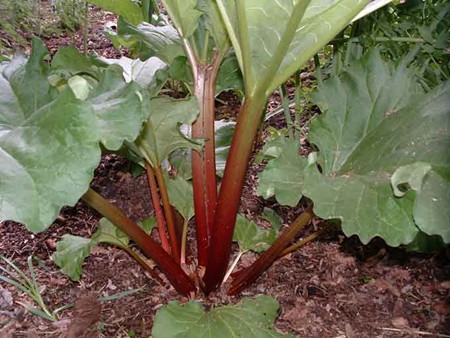Rhubarb: The Tasty Perennial
By Jos Van Hage

You know spring is here when the first young sprouts of Rhubarb emerge from the earth.
This perennial vegetable has been around for thousands of years originating from Mongolia in 2700 BC. It is one of the easiest plants to grow as it requires very little care and is rarely bothered by pests or disease.
Rhubarb grows in most types of soil provided it has some drainage. It can not sit in water for any length of time. It is grown by a storage root and from that there are smaller feeder roots. The underground stems produce buds which is where the edible stalks come from. Although it can be started from seed, it is most often and best grown from an existing root. The roots are available in the garden centers in the spring or young plants can be bought.
When choosing a site to plant the rhubarb think long term as the rhubarb will be growing there for many years to come. Most gardens have a rhubarb plant in the corner of the garden so that it is not in the way when Rotor tilling the soil or planting the vegetable garden. If you have no vegetable garden you could plant one in the flower bed as the foliage of the rhubarb is attractive looking.
To plant it, dig a hole around 45 cm round and add compost to the soil before planting the root 15 cm below the soils surface. Do not harvest any stalks off the plant in the first year as you want the plant to grow a strong and healthy root system first before you begin pulling stalks.
In the following spring you can begin to pull stalks from the plant. Pull a stalk by grabbing it lower down on the stalk and giving it a good tug. It should come off easily. Do not cut a stalk off the plant as you want to get the entire stalk rather than leaving a stub which could rot. When pulling the stalks you should leave at least one-third of the stalks on the plant so that they can continue to feed the roots. Only harvest stalks during the spring and early summer (mid July) so that the plant can restore itself for next year.
Sometimes a rhubarb plant will produce a large flower stalk and this should be removed as it is taking away important energy away from the plant.
For large healthy stalks feed the rhubarb each spring with compost or mushroom manure when you see the first new shoots.
Rhubarb should also be watered if the soil becomes too dry.
Every 6-7 years in the early spring or fall rhubarb should be divided by using a sharp spade and cutting the root so that each part of the root has at least 2 eyes. If you have more than one plant you can alternate years when dividing so that you can harvest rhubarb every year.
Although the stalks are very tasty and edible the leaves of the plant are not. They are poisonous and should be tossed in the compost or placed beside the crown of the plant as a weed barrier.
Two varieties that grow well in the Prince George area are ’Canada Red’ and ’Victoria’.
- Highway 97 North at the Northwood Pulpmill Road
- Highway 16 West on Kimball Toad across from the Bon Voyage Plaza
Previous Story - Next Story
Return to Home









